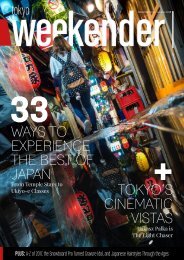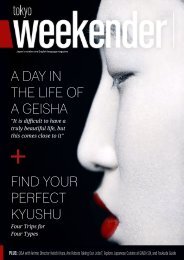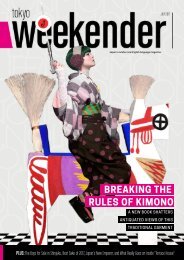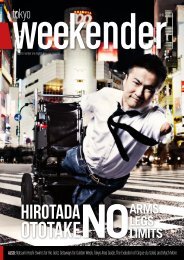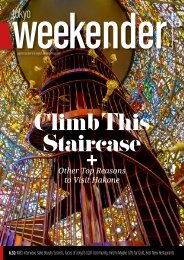Tokyo Weekender - November 2017
Our November issue is out, featuring a jam-packed end-of-year special: 42 Christmas gift shopping ideas and 10 bonenkai spots. Plus: The avant-garde world of butoh dance, Japanese teen prodigies, and a special supplement guide to Akita. Here's where to find a copy around Tokyo: www.tokyoweekender.com/pickup/
Our November issue is out, featuring a jam-packed end-of-year special: 42 Christmas gift shopping ideas and 10 bonenkai spots. Plus: The avant-garde world of butoh dance, Japanese teen prodigies, and a special supplement guide to Akita. Here's where to find a copy around Tokyo: www.tokyoweekender.com/pickup/
You also want an ePaper? Increase the reach of your titles
YUMPU automatically turns print PDFs into web optimized ePapers that Google loves.
A DIALOGUE<br />
WITH GRAVITY<br />
MEGURI@Sankai Juku<br />
Words by Annemarie Luck<br />
In the run-up to butoh dance<br />
company Sankaijuku’s<br />
performance in <strong>Tokyo</strong> this<br />
month, we chat with the group’s<br />
founder and choreographer<br />
Ushio Amagatsu about the<br />
avant-garde form of Japanese<br />
dance that has both unnerved<br />
and captivated audiences for<br />
nearly 60 decades<br />
I’m only 10 minutes into my interview with<br />
Ushio Amagatsu, founder of butoh dance<br />
company Sankaijuku, when he stands to<br />
demonstrate how he choreographs the<br />
abstract movements of his productions.<br />
So far, our conversation has also been pretty<br />
abstract, so I’m quite relieved that he’s chosen<br />
to show rather than tell at this point.<br />
“When creating a piece, my approach is<br />
completely different to other butoh companies,”<br />
he says. “I don’t use mirrors or music in<br />
the rehearsal room. Instead, I create virtual<br />
settings for each movement. Even if it is only<br />
two seconds long, every movement has an<br />
imagined story attached, and in this way the<br />
dance is built on layers of meaning.”<br />
Stretching his right arm out in front of<br />
him while pointing his forefinger towards<br />
the wall opposite us, he elaborates: “Imagine<br />
a very thin thread attached to your finger<br />
and dropping down. A miniature version of<br />
IT’S CHARACTERIZED BY INTENSE, OBSCURE<br />
MOVEMENTS PERFORMED BY DANCERS<br />
WITH SHAVED HEADS AND THEIR ENTIRE<br />
BODIES PAINTED IN WHITE<br />
yourself is hanging at the end of this thread.<br />
You, in turn, are also hanging by a thread,<br />
and being carried by a bigger, giant version of<br />
yourself.” He takes a snail-paced but purposeful<br />
step forwards, keeping his arm and finger<br />
in situ. “If you walk a single, small step in this<br />
context, you are carrying yourself, but you<br />
are also carried by yourself. This a very basic<br />
etude to describe how I choreograph a step.”<br />
If you’ve ever watched a butoh performance,<br />
you’re likely nodding your head as<br />
Amagatsu’s description calls to mind this<br />
minimalist yet deeply expressive form of<br />
contemporary dance. Founded in the 1960s<br />
by Hijikata Tatsumi and Ohno Kazuo, butoh<br />
(which means “the dance of utter darkness”)<br />
was born out of the confusion and desperation<br />
felt after World War II and the atomic<br />
bomb attacks on Japan. It was also an attempt<br />
by Tatsumi to return to Japanese aesthetics as<br />
he felt the country was becoming too heavily<br />
influenced by Western dance styles. It’s<br />
characterized by intense, obscure movements<br />
performed by dancers with shaved heads<br />
and their entire bodies painted in white. The<br />
performers are at once ghostly, unnerving,<br />
and captivating. In 1987, The New York Times<br />
summed it up as “the avant-garde dance form<br />
that today is Japan’s most startling cultural<br />
export,” and stated that “it sets out to assault<br />
the senses.”<br />
Decades later, Amagatsu’s company<br />
Sankaijuku, which he formed in 1975, is<br />
keeping this startling cultural export alive on<br />
stages around the world. The award-winning<br />
group has performed in 45 countries and vis-<br />
34 | NOVEMBER <strong>2017</strong> | TOKYO WEEKENDER



